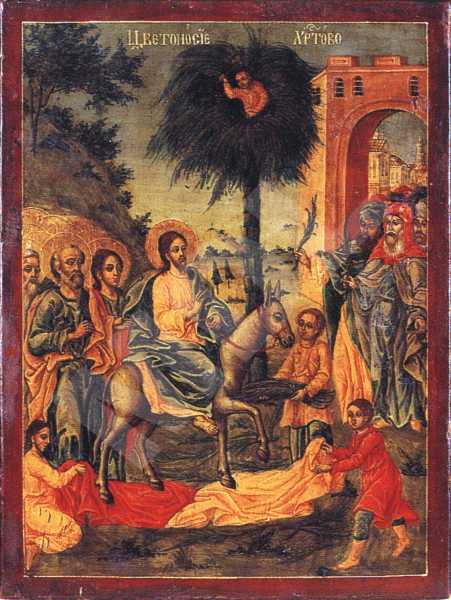The Entry into Jerusalem
Type:
Icon
Period:
The beginning of the
19 century
Toma Vishanov-Molera, born around 1750, painter of icons and murals, founder of the Bansko school of art. He grew up in the family of the clergyman Vishan. Around 1765 he went to Vienna, where he studied painting. It is not known who were his teachers there or when he returned to Bansko. His fellow villagers called him the Moler, Molera(from German Maler ‘painter’), whence the entire family's surname. Under the influence of the European 18th century art Toma Vishanov painted his works in a new manner, unknown until then in Orthodox art. The figures are realistic, vivid, expressive. Toma Vishanov is an innovator in the early period of Bulgarian Renaissance. His ideas on art were not understood and at first were rejected by his contemporaries. His work has not been studied extensively. He died after 1811 in Bansko.
Dimmensions (cm):
29
/ 22.5
/ 2
Location
Country: Bulgaria
Province: Blagoevgrad
Town: Bansko
Museum: Museum complex
Source
Country: Bulgaria
Province: Blagoevgrad
Town: Bansko
Church: St. Trinity
Object identification notes
Toma Vishanov-Molera (?)
Description
A traditional treatment of the theme. The central figure is that of Christ, mounted on a donkey with no saddle, holding in his hand the rein, and blessing with his right hand. He is followed by the twelve disciples, painted behind him, using the method of the "isocephaly" - a manner of painting a greater number of saints or righteous men used in the iconography. Only the figure of Saint Peter is painted in full length, and there is a slight hint of the faces of Saint John the Theologian an of Saint Andrew. At the gates of Jerusalem a group of lay people are welcoming Christ, greeting him with palm twigs. Painted in the second distance is a big tree, seated in which is the short man Zacchaeus, who is breaking twigs and throwing them to the welcomers. Several children are spreading a white cloak in front of the donkey with Christ on its back. Painted behind Christ and the disciples is a landscape: a steep slope and trees, and in the distance - mountains and a city. The scene is a solemn and festive one.
Iconographical technique: Tempera
The varnish cover is applied thinly and evenly.
Base material: Wood
The icon's base is a one-piece softwood panel. The ground coat is of plaster, laid thinly.
State, restoration traces and comments
There are no traces of any previous restorative intervention.


